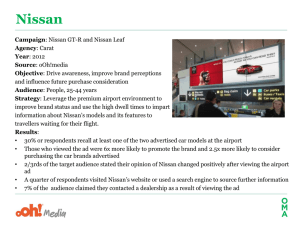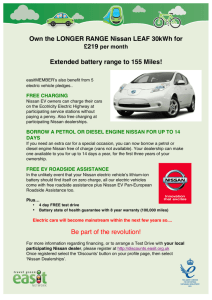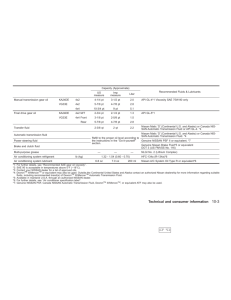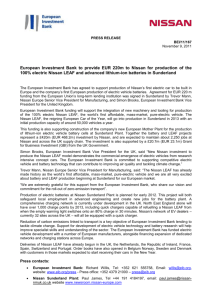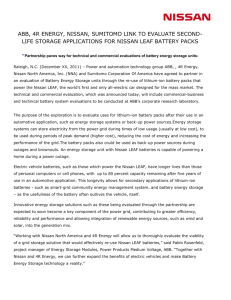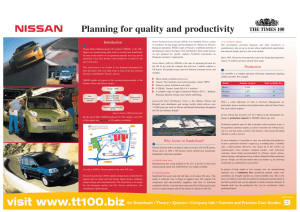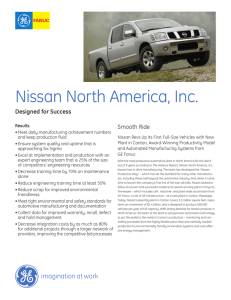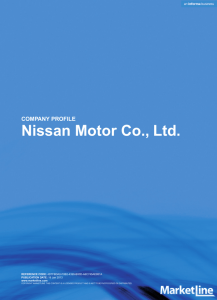quaternary,quinary case study
advertisement
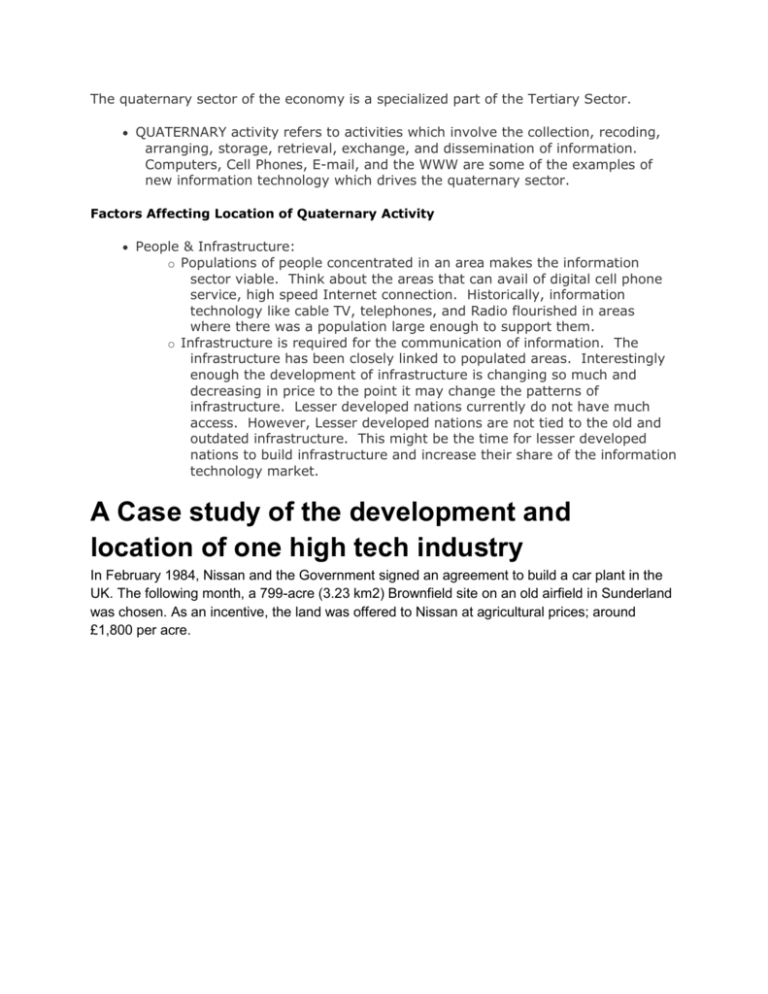
The quaternary sector of the economy is a specialized part of the Tertiary Sector. QUATERNARY activity refers to activities which involve the collection, recoding, arranging, storage, retrieval, exchange, and dissemination of information. Computers, Cell Phones, E-mail, and the WWW are some of the examples of new information technology which drives the quaternary sector. Factors Affecting Location of Quaternary Activity People & Infrastructure: o Populations of people concentrated in an area makes the information sector viable. Think about the areas that can avail of digital cell phone service, high speed Internet connection. Historically, information technology like cable TV, telephones, and Radio flourished in areas where there was a population large enough to support them. o Infrastructure is required for the communication of information. The infrastructure has been closely linked to populated areas. Interestingly enough the development of infrastructure is changing so much and decreasing in price to the point it may change the patterns of infrastructure. Lesser developed nations currently do not have much access. However, Lesser developed nations are not tied to the old and outdated infrastructure. This might be the time for lesser developed nations to build infrastructure and increase their share of the information technology market. A Case study of the development and location of one high tech industry In February 1984, Nissan and the Government signed an agreement to build a car plant in the UK. The following month, a 799-acre (3.23 km2) Brownfield site on an old airfield in Sunderland was chosen. As an incentive, the land was offered to Nissan at agricultural prices; around £1,800 per acre. Why was the government being so helpful? The North East region of England had recently undergone a period of industrial decline, with the closure of most of the shipyards on the Tyne and Wear, and the closure of many coal mines on the once prosperous Durham coalfield. What were the advantages to Nissan? The high unemployment this caused meant Nissan had a large, eager, manufacturing-skilled workforce to draw upon. The site was close to large ports on the Tyne and Tees, within easy driving distance of the international Newcastle Airport, and close to major trunk roads such as the A1 and A19. So what happened? The established company became known as Nissan Motor Manufacturing (UK) Ltd, or NMUK. A ground breaking ceremony took place in July, and work began on the site in November 1984. In December 1985, the finished factory was handed over to Nissan for the installation of machinery and factory components. In July 1986, phase 1 of the plant construction was completed, and the first car rolled off the production line. At this point, the factory consisted of a Body, Paint and Final Assembly Line. In February 1987, NMUK became the sole supplier of Bluebirds to the UK market. This was followed by the Plastics moulding and Engine assembly plants. It continued to produce a greater variety of models but was under severe competition from the new EU countries and other MICs were the costs were lower. But in 2003, when Ghosn took over the CEO position, he remarked the plant as one of the most productive of all plants, therefore saving it from closure. Increased production meant that by 2007, NMUK would be producing over 400,000 vehicles per year, up from the 2003 figure of 330,000. Why is a Nissan a high tech industry? NMUK relies heavily on Information Technology to function. Computer-controlled robots and other machinery, particularly in the Body Shop, are vital to production. These machines are maintained and controlled by specialist engineering teams. Other functions, such as the complex scheduling of vehicles, parts control and ordering, vehicle tracking, etc. are managed by software written in-house. Most of the software resides on an IBM Mainframe. This Mainframe is not just responsible for NMUK; it controls business functions across the Europe region, including NMUK's sister plant, NMISA, based in Barcelona, Spain. The Mainframe is located within the European Data Centre (EDC), which, as well as housing and maintaining the Mainframe and over 50 PC servers, acts as a European helpdesk. One of the innovative high tech technqiues enables Nissan to practice 'Just in time' ordering of components. This means that the system is designed so that parts arrive very close to the time when their required. This reduces costs by doing away with the need for large areas of storage cutting out the need for a large workforce in the stores cutting bank interest How is this achieved? When a vehicle starts it journey through the plant, a transponder is attached in which is stored all the information on the exact specification of the vehicle, from colour to trim to engine size. At each point along the way, this information informs the robots and/or humans exactly what to fit. But the neat part is ordering parts needed further down the line. At a particular point in its journey, it has been worked out for example, that a set of red seats with blue trim will be needed in 5 days. As the vehicle passes that point an order is to the seat supplier directly. Have 4 red seats with blue trim here in 5 days. And when the vehicle gets to the body shop, there they are, waiting! Recent developments On the 8th January 2009, Nissan announced it was to shed 1200 jobs from the factory due to the automotive industry crisis of 2008. as the 3rd night shift was removed, returning the factory to 2 shifts a day. However, later that year, 150 workers were taken back on, due to increased production resulting from the scrappage schemes implemented across Europe as a result of the recession. These schemes paid people a fee for scrapping older, high polluting cars in favour of buying new ones. Tuesday, 21 July 2009 Nissan has announced plans to build a plant for the production of its advanced lithium-ion batteries in Europe, the first significant step towards producing batteries for its Zero Emission Mobility Program in Europe. As part of the newly established Low Carbon Economic Area, Government intends to establish a new training centre, specialising in low carbon automotive technologies; a technology park and an open access test track for low carbon vehicles. Research takes places at the Centre for Advanced Electrical Drives at Newcastle University and Sunderland University’s Institute for Automotive and Manufacturing Advanced Practise (AMAP) provides design consultancy and state-of-the-art training for both new entrants and experienced engineers. Friday, 18 December 2009 Regional Development Agency One North East and car manufacturer Nissan Motor Co., today entered the next phase of their partnership on the development of zero emission mobility in North East England. Under the agreement, One North East will install at least 619 publicly available, ‘future-proof’ charging points by January 1, 2011, which will support both 3kW and 7kW charges and twelve 50kW ‘rapid-charging’ stations. Electricity at the 619 charging points will be provided free of charge until March 31, 2012. Nissan has agreed to supply Nissan LEAF electric vehicles to the region in early 2011 and to place priority on requests for electric vehicles in the UK from North East England. Nissan LEAF is the world’s first affordable electric vehicle. Designed specifically for a lithium-ion battery-powered chassis, the medium-size hatchback comfortably seats five adults and has a range of more than 160km (100 miles) to satisfy real-world consumer requirements. Update: £20 million grant to Nissan will go ahead, confirmed David Cameron. This secured the long term investment by Nissan to add to the battery production site with the Leaf production, which will now go ahead. This grant, scheduled by Labour, was under threat as a result of the current round of cut-backs. Barcelona and other sites in Europe were all hoping the Leaf production would go to them, but Leaf will be coming off the production line in Sunderland by 2013. One of the unacknowledged downsides of electric vehicles is the cost and the lifetime of the batteries. together with the amount and nature of the material that goes to make one. Nissan and its French partner Renault SA are aiming to lead the market for battery-run electric vehicles with a global launch on a mass scale in 2012. The alliance's first mass-volume allelectric car, the Nissan Leaf, is due to hit the Japanese and U.S. markets this December. So Nissan, which develops and produces the lithium-ion batteries (in Sunderland) in a joint venture with NEC Corp, wants to lower the high cost of electric vehicles by eventually giving their expensive batteries a second life through re-use, resale, refabrication and recycling. Japan's Nissan Motor Co and Sumitomo Corp said on Wednesday they had formed a joint venture aimed at commercializing used lithium-ion batteries for electric cars. http://planetark.org/wen/59545
